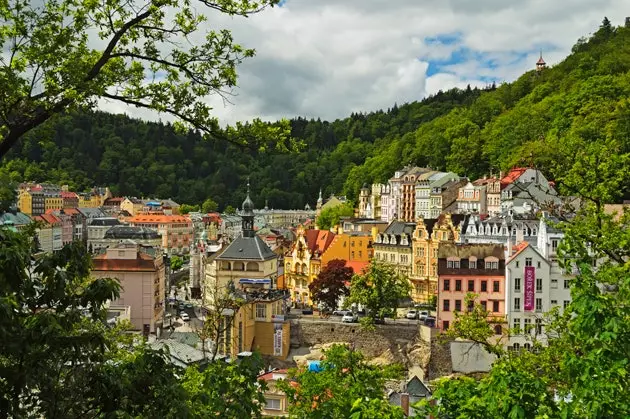
Karlovy Vary
A Czech friend has a recurring dream: he imagines a public fountain in Prague endlessly gushing out gallons and gallons of lager. I don't know why, really. In a Czech tavern, a bottle of water is more expensive than a pint of beer (which is around 30 kc, just over €1 in exchange) and the Czechs do not need public fountains to encourage them to drink beer, they are by far the world leaders in consumption with an average per capita of 145 liters per year . In fact, if we take into account that the average includes the child population in the calculation (with zero consumption, that is), it can be said that lovers of Czech beer like my friend far exceed the national average and drink a year more beer than water. Even Nikol, the beautiful model in this report, loves the lager. They are surplus. They don't need alfaguaras of beer.
In Karlovy Vary , nevertheless, they love water fountains . It is not a simple dream. They number and baptize them, measure the temperature of their water, frame them between rococo porches, erect romantic kiosks, integrate them into urban planning with granite beds and Corinthian colonnades, build entire buildings to safeguard them... the whole city grew around a fountain.
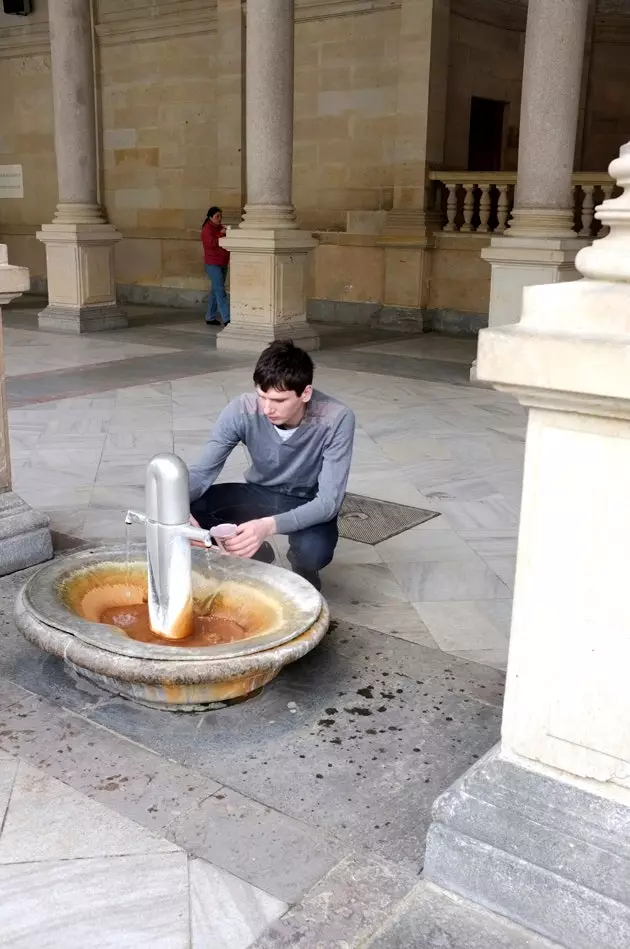
Veneration for water and fountains
Yes, we are still in the Czech Republic. Karlovy Vary is located a couple of hours drive from Prague, about 120 kilometers. We are very close to the border with Germany, in a region that is a world seaside power. In western Bohemia there is the 'Bermuda Triangle' of mineral-medicinal waters and rich peloid deposits, formed by the cities of Karlovy Vary, Mariánské Lázne and Františkovy Lázne , also known as Karlsbad, Marienbad and Franzensbad in their German spelling.
Here the bathrobes are as typical as the kimono in Japan, and one of the most repeated images is that of the walkers with a porcelain jug in hand , the equivalent of the mate bulb for the Argentines, who use it to drink water from the fountains as soon as they have the chance.
For centuries, before the Iron Curtain fell on Czechoslovakia, Karlovy Vary shone like a legendary spa town in the woods, with cream-colored rococo buildings and arcaded passageways, where Beethoven, Liszt and Chopin, as well as Goethe, Tolstoy, Turgenev, Karl Marx and Sigmund Freud, they came to disappear in a sea of treatments with medicinal waters.
Today the splendor of the city and above all the business continues. Spa hotels flourish with their own medical staff that treats digestive and cardiovascular disorders, diabetes, cholesterol and different joint problems through cures with water. The ideal stay is two or three weeks. During the communist period, the spas, originally the preserve of the aristocracy and bourgeoisie, began to receive the influx of workers and retired workers subsidized by the State. Now, along with Czechs, Germans and Arabs, Russians on vacation dominate. In fact, Karlovy Vary feels like his second home.
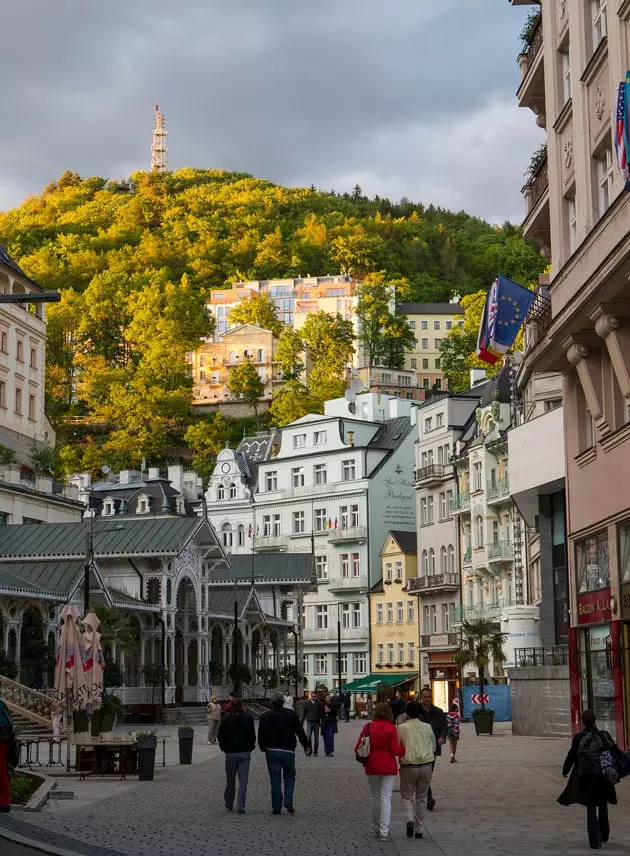
The quiet and charming center of Karlovy Vary
The Russian presence is noted . The links were born during Tsarist Russia with the visits of Tsar Peter I, they grew with the USSR thanks to the paid stays for its officials, who spent several weeks resting in its sanatoriums and thermal baths, and mature today with capitalist Russia. : the small Karlovy Vary airfield receives direct flights from Moscow, Cyrillic is ubiquitous in daily routines , the Russian-orthodox church of sv. Petr a Pavel crowns the city and there is even a holiday village on the outskirts where only Russian residents reside.
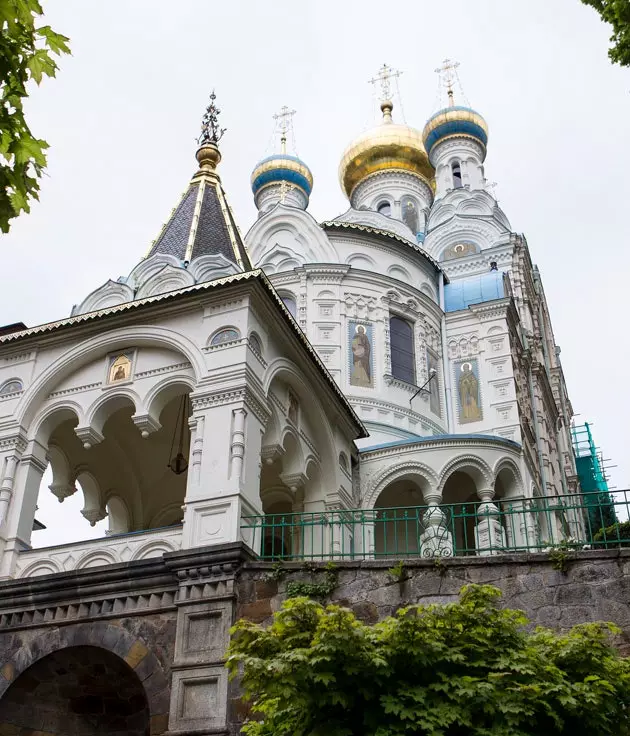
The Russian presence here is evident even in the architecture
WATER CAPITAL
“Those of us who live in arid parts of the world feel a reverence for water that elsewhere may seem excessive,” Joan Didion once wrote. In Karlovy Vary there is plenty of water and bowing is done with the head and trunk bowed . The Californian writer liked to imagine the route of the water to her tap in Malibu, how it crossed the Mojave desert through aqueducts and pumps and siphons and dams and drains, through that large-scale plumbing. In Karlovy Vary the water is under your feet . The city rises on a gigantic aquiferous raft.
80 springs sprout from the subsoil that pour nearly six million liters of water with a high mineral content every day. You have to use your imagination to discern why in an inch of land there are sources of cold, hot and boiling water; drinking water sources and extremely sulfurous sources; laxative sources, to treat blood circulation, osteoarthritis...
Along with autumn, when the forests of this part of Bohemia are ablaze with vivid colors reminiscent of the 'Indian summer' of the Canadian forests, the best time to approach Karlovy Vary is the month of July , during the celebration of the International Film Festival. On the continent it does not reach the prestige of Cannes, Berlin or Venice, but it is up to the task, it already has 48 editions, the city is rejuvenated by the young 'gafapasta', there are more than 200 film screenings and queuing at the hot springs you can find both Russian grandparents in treatment and movie buffs and famous figures of the stature of Oliver Stone, John Travolta, Isabelle Huppert, Morgan Freeman, or John Malkovich.
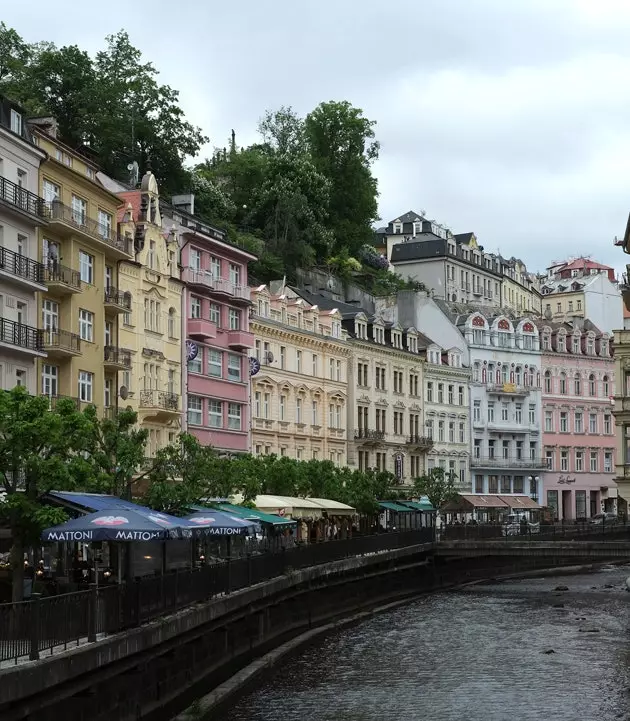
Water and Karlovy Vary are synonyms
Although celebrities often stay at the Grandhotel Pupp, The festival's main venue is an angelic reinforced concrete block with 273 rooms that rises without dissimulation on the banks of the Teplá River in the historic center of the spa city. This is the ** Thermal Spa Hotel. **
For some, this cement skyscraper with which the communist government wanted to break the classical architectural harmony in 1977 It's pure avant-garde . For others, a veritable hot spring of irritability , an aesthetic attack that portrays the dictatorship. It must be recognized at least that its thermal water pool, located outdoors on a high point on a rock a hundred meters from the building, has fabulous views of the city. A perfect natural viewpoint is that of Rozhledna Diana, which can be reached by funicular. The descent is worth doing through the forest, on a friendly, well-marked path.
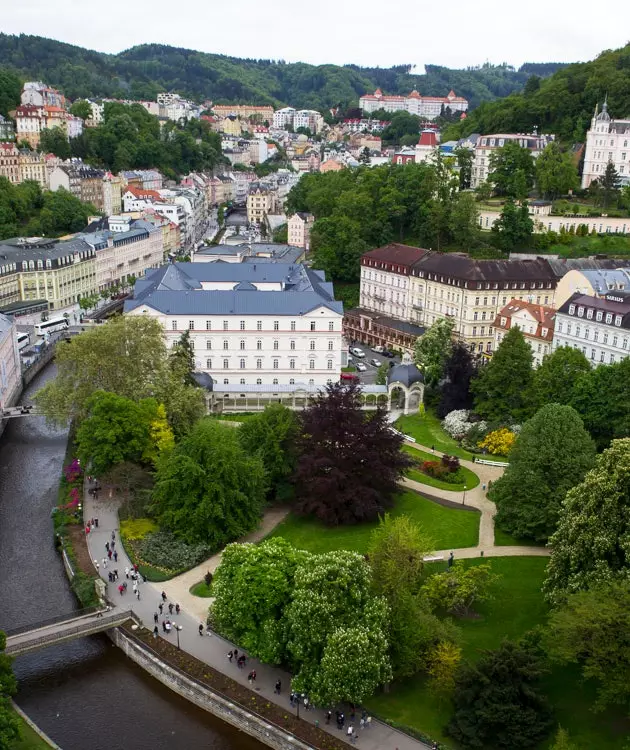
Thermal Spa Hotel
On Nová Louka Avenue is the neo-baroque theater (Mestské Divadlo). You have to know your stalls especially before the curtain rises. His drawings are the work of the Austrian painter Gustav Klimt , one of the great protagonists of the Viennese Secession. It is a canvas for giants of 94 m2 that would fit in few museums in the world. He is still a young Klimt, but he already manifests his weakness for lust and beauty. Accompanied by his brother Ernest and Franz Matsche, he was also in charge of the frescoes on the vault.
Another Austrian also worked in the theater, although his work was less creative. Adolf Hitler harangued from the balcony on more than one occasion to the large German population of the area during the Third Reich.
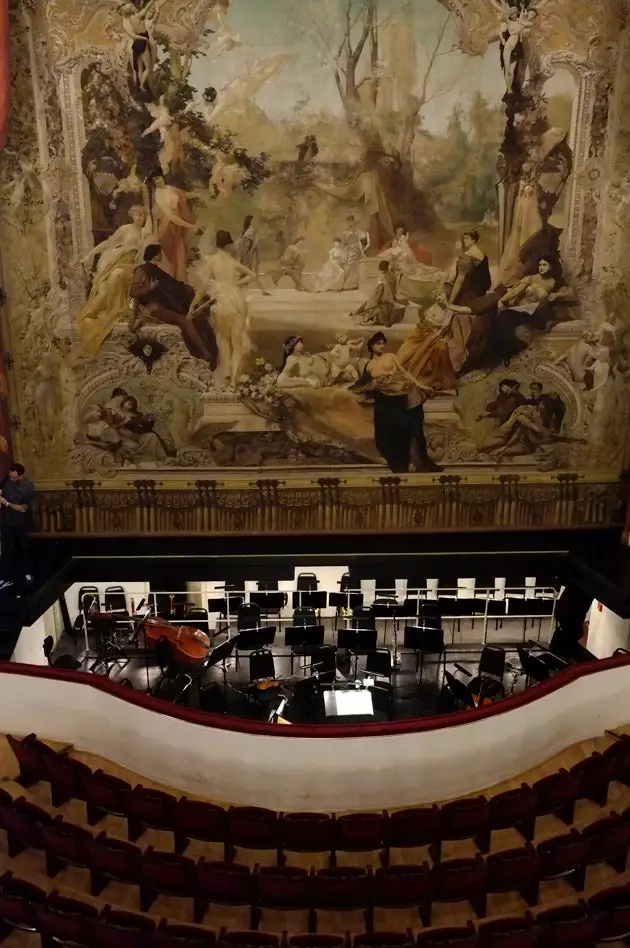
The Klimt work that wouldn't fit on a museum wall
BEER CAPITAL
Water, let's not forget, is a fundamental ingredient in brewing –pivo, in Czech– . As we are in western Bohemia, it is worth escaping to the capital of the region and, perhaps, the beer. Between Karlovy Vary and Pilsen –Plzen– there are barely 80 kilometers. The road winds between gentle hills that hide agricultural villages where cultivated fields of hops and barley announce your destination.
The fourth largest Czech city in population has the third largest synagogue in the world, the tallest tower in the country –102.6 m , in the gothic cathedral of San Bartolomé; you can go up and enjoy a vertiginous google earth view in the heart of the city – and beer, lots of beer. Pilsen is the perfect complement to Karlovy Vary. Here a Bavarian conceived the lager beer.
The invention, like so many things, started with a bang. The beer tradition comes from old, but it was not until the 19th century that beer was made as we drink it today , the most widespread, the low fermentation pivo or lager beer. In 1838, Pilsen aldermen dumped 36 barrels of beer down the local sewer in a tantrum against the poor production of beer that had come their way. From then on, the City Council would control the production of beer with a limited licensing of 260 masters and invested in a municipal factory for which they signed the Bavarian master brewer Josef Groll.
In 1842 the miracle happened. Until that moment beers were dark, dense, thick, poorly filtered . The concoction had to be hidden in the porcelain jugs that our grandmothers bring us today when they go on vacation to Bavaria. On November 11 Groll appeared with an oak barrel in the San Martin de Pilsen market . Inside was soft water, hops from Žatec and barley malt fermented with yeast. It is easy to imagine the expression of the first lucky person who tasted that golden, semi-transparent, refreshing liquid in a glass jar filled with fluffy white foam.
In Pilsen you can visit **the didactic Prazdroj brewery** in Pilsner Urquell. Urquell in German and Prazdroj in Czech mean 'original source' . As it turns out, Bohemia is a source region.
In Pilsen, by the way, the first mulattos of Czechoslovak nationality were seen. It is not uncommon today to see on the street black neighbors with light eyes and perfect slavic diction . They are the descendants of the happy nights spent by American recruits after the liberation of the city during World War II in 1945. Every May 6, the Nazi defeat is remembered with devotion at the hands of US troops led by General George Patton, who ended his triumphal journey here and did not have Allied permission to continue to Prague. The candy of the liberation of the capital was eaten by the Soviet Army.
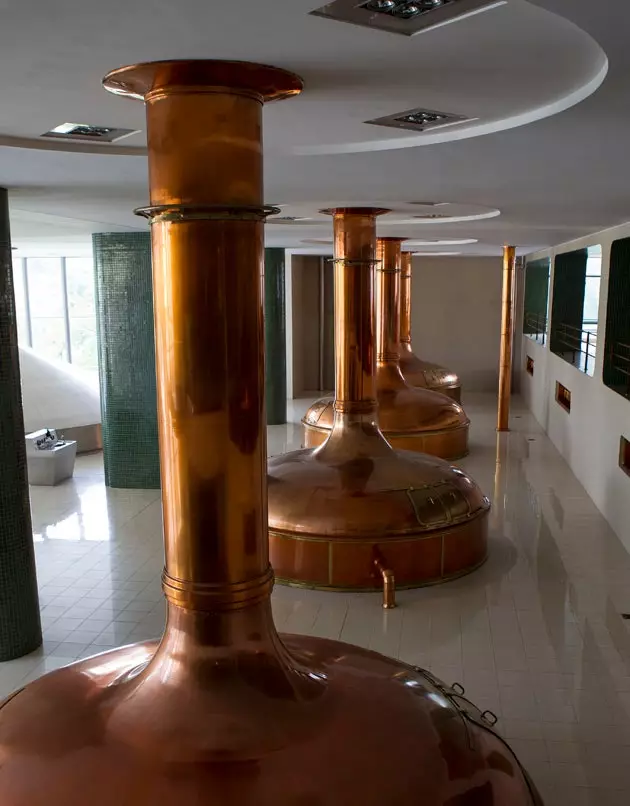
Brewery in Pilsner
STORY OF A DISAPPOINTMENT
If Pilsen is beer, Mariánské Lázne and Františkovy Lázne are water. And Goeth. If Hemingway was in the whole world, goeth was here . Bohemia does not stop remembering it. He has a museum and a statue in Mariánské Lázne, a statue also in Karlovy Vary and another in Loket, a consecrated hotel in Františkovy Lázne.
The German writer spent his good seasons in spa towns. In 1821, aged 72, old and hardened by life, he fell madly in love with a 17-year-old girl, Ulrike von Levetzow. After two years of epistolary courtship she decided to ask for her hand in Mariánské Lázne. After all, it was he who wrote, Johan Wolfgang von Goethe, no less than the most important German writer of all time. She gave him pumpkins. Goethe, overwhelmed, never got over the disappointment in love and he never returned to Bohemia. From now on he would only live to work. In the same carriage that took him back home he began to write the beautiful Elegy of Marienbad . Ulrike, however, would not marry any other suitor throughout her life and when she died she asked to be cremated with Goethe's love letters.
For Stefan Zweig, this sentimental failure and literary triumph of Goethe is one of the stellar moments of humanity. For the Czech journalist who reminded me of the episode, a simple skirt story: "It is often omitted that Goethe had already been Ulrike's mother's lover."
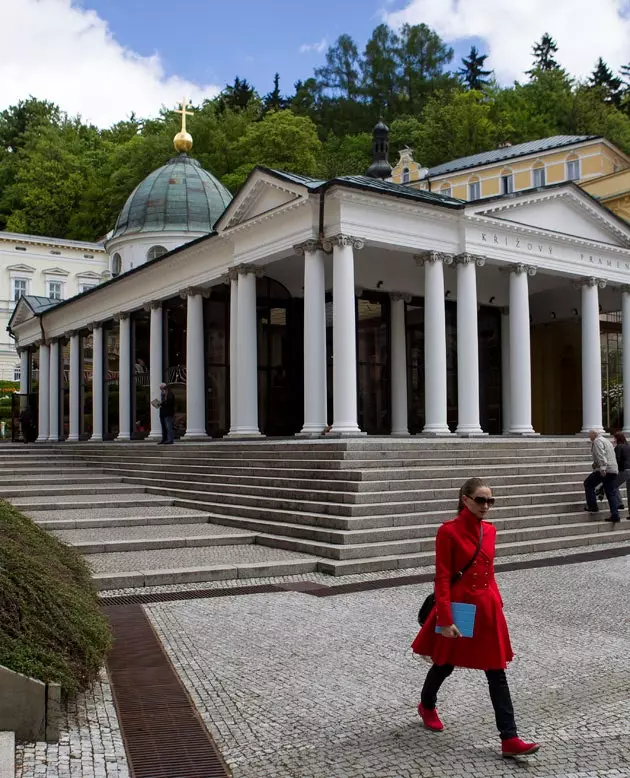
Marianske Lazne
Mariánské Lázne, Marienbad in German, is a charming spa town of just over ten thousand inhabitants. Calmer than Karlovy Vary and with more German than Russian ancestry , is also a prodigy of hot springs. In the city emerge more than fifty cold mineral springs that successfully cure kidney diseases, nervous, digestive and respiratory conditions, as well as skin and musculoskeletal conditions. By the way, every August the city hosts the Fryderyk Chopin International Music Festival.
Complete the triangle of spa towns Frantiskovy Lazne . At 45 kilometers from Karlovy Vary, it is by far the quietest of the three. Goethe called it an "earthly paradise" . Its waters, its 23 sources, cure almost everything. Except for lovesickness.
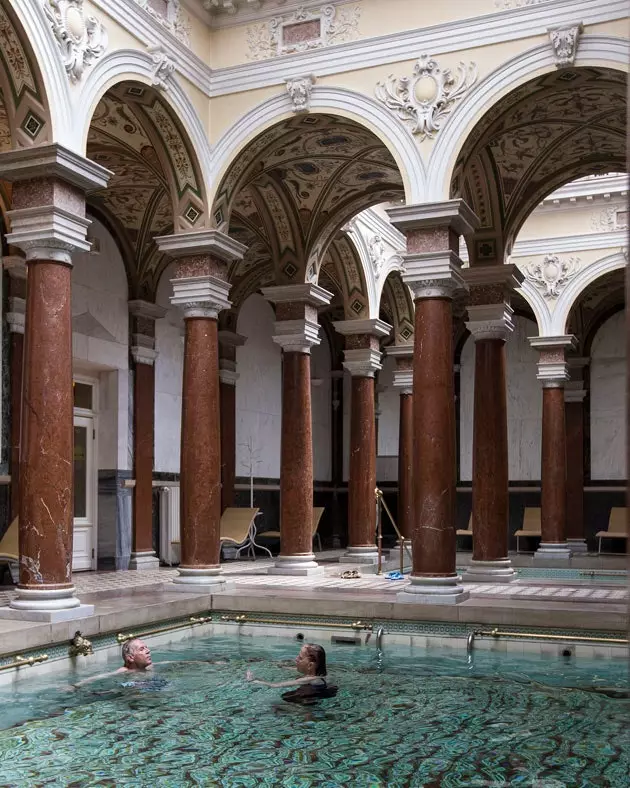
Nové Lazne Spa in Mariánské Lázné
